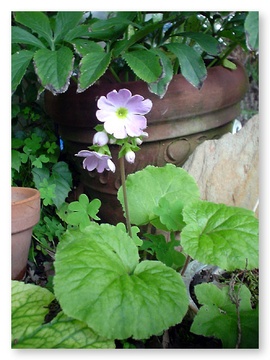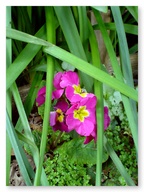Primroses (Primula spp.) form a large genus with a well-deserved reputation as aristocrat of the shade garden. They are mostly hardy perennial herbs and are natives of Europe and temperate Asia, Java and North America; only one kind, P. magellanica, is found south of the equator, in southern South America. Some primroses, such as the English Primrose, bear their flowers singly on stems that rise straight from the base of the plant, while others produce their clusters of flowers in a head or umbel at the top of the flower stem.
Most species need moist, rich soil, and want a cool location with light shade. The summers are too hot over most of the U.S. for growing many primroses, and survival in areas with very hot summers like we have in Davis probably depends largely on picking the right microclimate along with selection of a hardy variety.
One species is native to Davis: Padre's Shooting Star (Primula clevelandii). It is a perennial herb that prefers full sun or partial shade and is generally found in open grassy areas. It is spring deciduous, dying back to the ground when the rainy season ends. It has a basal clump of leaves up to six inches long with and a flower stem up to one foot tall. Its flowers can be magenta, deep lavender, or white.
There is one other species native in Yolo County: Broadleaf Shooting Star (Primula hendersonii), also known as Mosquito Bills or Sailor Caps. This species grows in the foothills, including the Capay Hills, and as low as Esparto, but not east of I-505. It prefers partial shade or full shade and is generally found in open woodlands. It hybridizes with Padre's Shooting Star and is the same size, has the same range of flower colors, and dies back to the ground at the same time of year. The two species can be visually distinguished mainly by the fact that Broadleaf Shooting Star has a reddish or purplish flower stem, whereas Padre's Shooting Star has a green flower stem.
Hardy non-native primroses can also be grown successfully in Davis, provided that they are watered generously in dry weather and given a soil so rich in humus or vegetable matter that it acts like a sponge; large quantities of leaf mold, cow manure, peat or sphagnum moss should be mixed into the soil. Our Davis climate results in some winter and early spring blooms, but the plants sometimes struggle through our hot summers.
Primroses can be propagated by division in early spring or fall.
For a listing of other plants found growing in Davis, visit our Town Flora.





